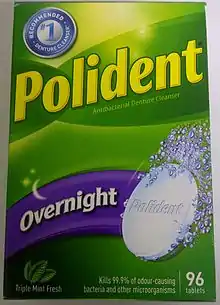Denture cleaner
A denture cleaner (also termed denture cleanser) is used to clean dentures when they are out of the mouth. The main use is to control the growth of microorganisms on the dentures, especially Candida albicans, thereby preventing denture-related stomatitis. When dentures are worn in the mouth, a biofilm develops which may be similar to dental plaque. It may become hardened and mineralized as dental calculus. Denture cleansers are also used to remove stains and other debris that may be caused by diet, tobacco use, drinking coffee, drinking tea, etc.


Some chemical denture cleaners can come in cream and liquid format. Others come in powder, paste, or tablet format. Some chemical denture cleaners are effervescent and others are not. There are also mechanical denture cleaners such as denture brushes and ultrasonic denture cleaners that use ultrasonic cleaning, some coupled with ultraviolet light.
Ingredients
Dilute sodium hypochlorite (i.e. a mild bleach) is the main constituent of several brands of denture cleanser.
Other ingredients include such chemicals as:
- sodium bicarbonate – or baking soda, which alkalizes the water, cleaning the dentures
- citric acid – removes stains
- sodium perborate
- sodium polyphosphate
- potassium monopersulfate – cleaning and bleaching agent
- EDTA
Example commercial brands
- Dentural (sodium hypochlorite solution)
- Milton (sodium hypochlorite solution)
- Mildent (sodium hypochlorite solution)
- Steradent (alkaline peroxides)
- Polident
- Renew Denture Cleaner
- Efferdent
- Novadent
History
Dentures have been cleaned using water or mixtures of water/vinegar, water/lemon juice, water/baking soda for many years. In the 1930s, Alexander Block developed the Polident brand of denture cleaner at the Block Drug Company.[1] Others have followed such as Warner-Lambert's introduction of Efferdent denture cleanser tablets in 1966[2] and Renew denture cleaner powder in 1986 by Mid-Continental Dental Supply Co. Ltd.[3] Over time, orthodontic and sport dental appliance cleaners have also emerged on the market such as Renew Ortho & Sport with formulations that account for thermoplastics and a younger demographic of patients.[4][5][6]
Clinical trials and evidence
Studies have found an association between denture stomatitis, colonization of yeasts and denture cleanliness.[7] Another study found that immersing dentures in 0.5% NaOCl solution for 3 minutes only can be an effective synergic for denture cleaning in reducing the number of microorganism without affecting the denture colour or surface roughness,[8] and when compared to alkaline peroxides, NaOCl was more efficient.[9] Some clinicians recommended that the time of immersion, and the concentration of the NaOCl should be well considered so as not to degrade the acrylic resin of the denture.
References
- "New Chip at the Old Block?". Forbes. May 29, 1978. p. 48.
- "History of Block Drug Company, Inc. – FundingUniverse". www.fundinguniverse.com. Retrieved 2020-06-11.
- "Mid-Continental Dental Supply Co. Ltd. - Visit us at IDS 2019: Hall 2.2 Aisle D-066". www.infodent.com. Retrieved 2020-06-11.
- "Mid-Continental Dental Supply Co. Ltd. - News".
- "Prestige Dental Products UK".
- "IDS 2019 Product Release".
- Kulak-Ozkan, Y.; Kazazoglu, E.; Arikan, A. (2002). "Oral hygiene habits, denture cleanliness, presence of yeasts and stomatitis in elderly people". Journal of Oral Rehabilitation. 29 (3): 300–304. doi:10.1046/j.1365-2842.2002.00816.x.
- de Sousa Porta, Sheila Rodrigues; de Lucena-Ferreira, Sílvia Carneiro; da Silva, Wander José; Del Bel Cury, Altair Antoninha (2013-12-12). "Evaluation of sodium hypochlorite as a denture cleanser: a clinical study". Gerodontology. 32 (4): 260–266. doi:10.1111/ger.12104. ISSN 0734-0664. PMID 24329765.
- Peracini, Amanda; Regis, Rômulo Rocha; Souza, Raphael Freitas de; Pagnano, Valéria Oliveira; Silva, Cláudia Helena Lovato da; Paranhos, Helena de Freitas Oliveira (2016). "Alkaline Peroxides Versus Sodium Hypochlorite for Removing Denture Biofilm: A Crossover Randomized Trial". Brazilian Dental Journal. 27 (6): 700–704. doi:10.1590/0103-6440201600913. PMID 27982182.